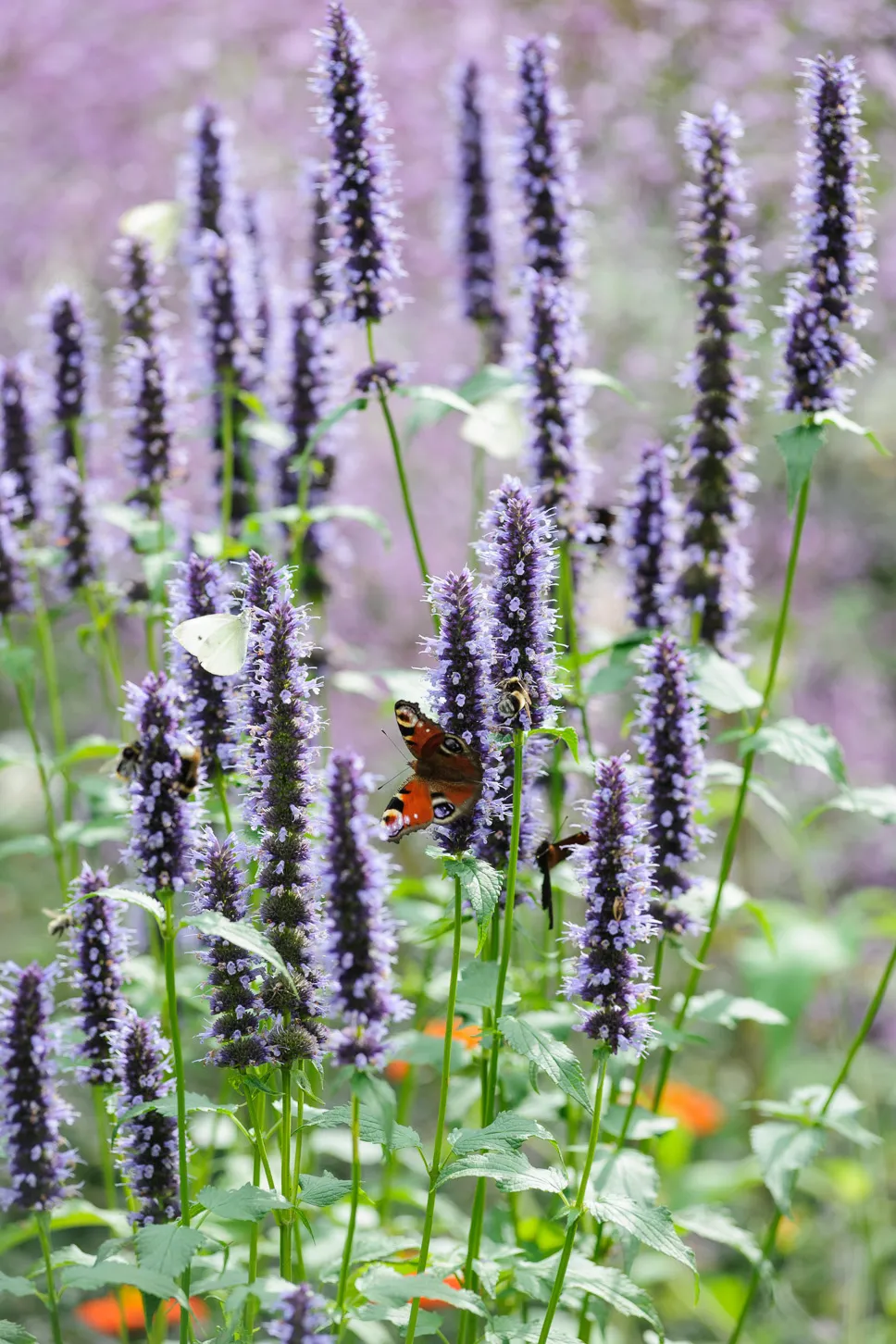We asked five leading designers to choose their key plants for sustainability. Marian Boswall, Conrad Batten, Olivier Filippi, Tom Massey and Nigel Dunnett all chose the plants they'd feature in their garden with sustainability in mind.
Don't miss our list of 100 beautiful plants and flowers and our round up of 60 early summer plants.
Sustainable plants: the best sustainable plants, chosen by experts, for your garden
Nigel Dunnett
Nigel’s choices are all robust plants with strong character that fit nicely into the layers of naturalistic plantings, and above all have multiple seasons of interest. Find out more about Nigel's influences, style and work at nigeldunnett.com. Discover his garden here.
ACTAEA ‘QUEEN OF SHEBA’
Striking, dark purple-black foliage and arching racemes of scented white flowers in late summer – a long-season plant of great value. Really special gem for shade. H 1.5m. S 60cm. C Moist soil; sun to part shade. SI Spring to 38 autumn. HR RHS H4, USDA 4a-8b.
AGAPANTHUS ‘WHITE HEAVEN’
Really large heads of pure-white flowers in late summer over evergreen foliage. These are so exotic, but what I really like, in addition, are the papery seedheads and prominent pure black seeds, adding so much extra value. H 1m. S 50cm. C Moist but well-drained soil; sun with some shelter. SI Summer to autumn. HR RHS H4, USDA 7a-10b.
AMMI MAJUS

Produces beautiful, billowing clouds of pure white from June through to September. A hardy annual that is easy from direct sowings outside in spring. Looks lovely scattered through perennials. AGM. H 1m. S 50cm. C Well-drained soil; sun or half-shade. SI Summer. HR RHS H6.
- Buy now from Crocus (£2.99)
ANEMONE X HYBRIDA ‘HONORINE JOBERT’
Pure-white flowers in virtually never-ending abundance – starting in July and going on into November at head height. Perfect for bringing light into shady places. Needs plenty of space of course. AGM. H 1m. S 50cm. C Moist but well- drained soil; sun or part shade. SI Year round. HR RHS H7, USDA 4a-8b.
ASTER X FRIKARTII ‘MÖNCH’
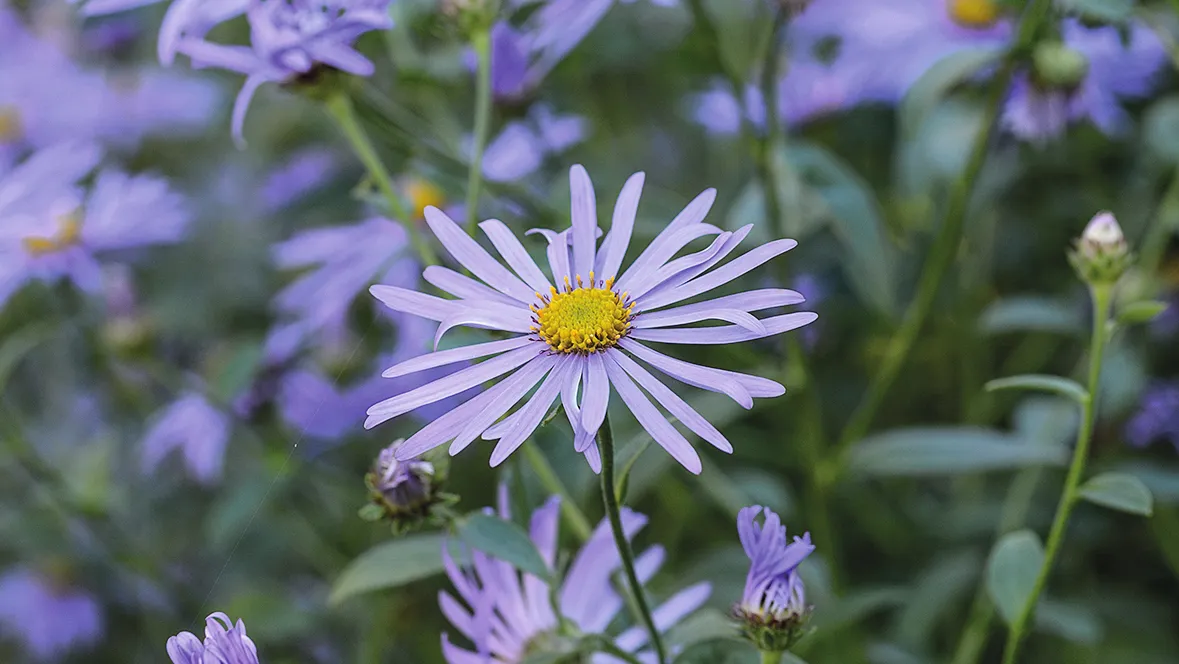
Is this the longest-flowering aster? Probably. It starts in August, and is often still going in November. The plants are open and quite floppy, but there’s no need to support them if you use them among plants they can weave through. AGM. H 60cm. S 50cm. C Moist but well-drained soil; full sun. SI Summer to autumn. HR RHS H7, USDA 6a-10b.
ASTILBE CHINENSIS VAR. TAQUETII ‘PURPURLANZE’
What a true multi-season plant! Its leaves emerge cherry-red in spring and then develop into lovely ferny foliage. The flower spikes in bud are beautiful, the purple-pink flowers shine, and the seedheads stand all winter long. AGM. H 1m. S 50cm. C Moist soil; full sun. SI Year round. HR RHS H7, USDA 4a-8b.
CALAMAGROSTIS BRACHYTRICHA ‘MONA’
A wonderful, medium-size grass that looks good virtually every day of the year. The shoots emerge olive green, with purple leaf and flower stems. The silvery-grey, fluffy flowerheads are pink-tinged and it bleaches out perfectly all winter. H 1m. S 1m. C Well-drained soil that is not too dry; sun or partial shade. SI Year round. HR RHS H6, USDA 4a-9b.
DIANTHUS CARTHUSIANORUM

A real go-to plant for dry meadow and steppe plantings. Produces heads of small, vibrant, pink flowers on long stems, over several months. Will self-seed around if happy. A green-roof stalwart. H 40cm. S 30cm. C Dry, well-drained soil; full sun. SI Spring to summer. HR RHS H7.
ERIGERON ANNUUS
A real pop-up plant! Delicate, small, white daisy flowers from August to December – really beats any white-flowered aster hands down. Great for mingling with robust perennials. Simply thin out seedlings each year where they’re not wanted. H 1m. S 50cm. C Light, well-drained soil; full sun. SI Summer to winter. HR RHS H6, USDA 2a-7b.
GERANIUM PATRICIA (= ‘BREMPAT’)
Patricia has lime-green young leaves, and an amazingly long flowering time, from early summer through to November, and is almost a vine, sending out weaving branches that wind their way through other plants, popping out all over the place. Great naturalised into a meadow. AGM. H 50cm. S 2m. C Moist but well-drained soil; sun or half shade. SI Spring to autumn. HR RHS H7, USDA 4a-8b.
Read our geranium plant profile here.
HESPERANTHA COCCINEA ‘MAJOR’
There’s something very special about the sheer lusciousness of these tall spikes of crimson- red flowers in late summer and early autumn. Nice to mingle among Rudbeckia fulgida for a startling combination. AGM. H 70cm. S 30cm. C Moist but well-drained soil; sun. SI Autumn. HR RHS H4, USDA 7a-9b.
HEUCHERA VILLOSA ‘AUTUMN BRIDE’
Lovely mounds of soft, downy foliage look good from spring through to autumn and then take on fantastic autumn colours. Tall spikes of cream flowers. Works well among open, multi-stem shrubs or trees. H 60cm. S 40cm. C Moist, not too dry soil; sun or half shade. SI Spring to autumn. HR RHS H6, USDA 3a-8b.
HYDRANGEA ASPERA VILLOSA GROUP
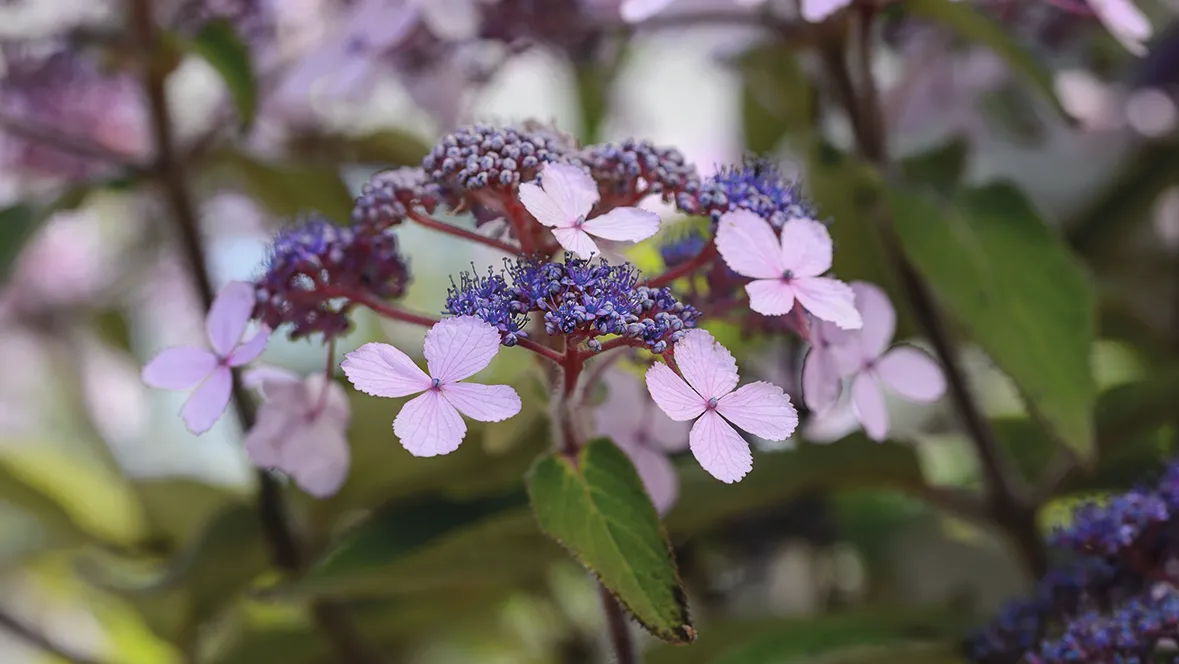
Greyish, felted, sensual leaves, purple and white flowers, beautiful flaking bark in the winter and an open structure, this is a magnificent shrub for structuring woodland-edge plantings. H 2m. S 2m. C Moist but well-drained soil; sun or part shade. SI Year round. HR RHS H5.
MISCANTHUS SINENSIS ‘SILBERFEDER’
A totally reliable Miscanthus that produces masses of flowers – which is what I grow Miscanthus for – in autumn. These stay on right through the winter. And it still looks great in January. Very upright plants, and the leaves have a silver mid-rib. AGM. H 1.5-2m. S 1m. C Moist but well-drained soil; sun. SI Year round. HR RHS H6, USDA 4a-9b.
- Buy now from Thompson & Morgan (£27.79)
NARCISSUS ‘ACTAEA’
The flowers of this gorgeous daffodil are oh-so elegant and beautifully scented too. The white flowers are combined with a small, yellow-orange cup that has a darker rim. Lovely in clumps and groups, but naturalised en masse in a meadow it’s breath-taking. AGM. H 30cm. S 30cm. C Moist but well-drained soil; sun to part shade. SI Spring. HR RHS H6, USDA 4a-8b
Don't miss our pick of the best narcissus to grow.
PRIMULA VULGARIS

Indispensable herald of the gardening year. And not just for woodland shade: use it as an early flowering base layer among perennial plantings – it feels at home under the taller herbaceous canopy. AGM. H 20cm. S 20cm. C Moist but well-drained soil; full sun to part shade. SI Spring. HR RHS H7, USDA 4a-8b.
PULMONARIA ‘DIANA CLARE’
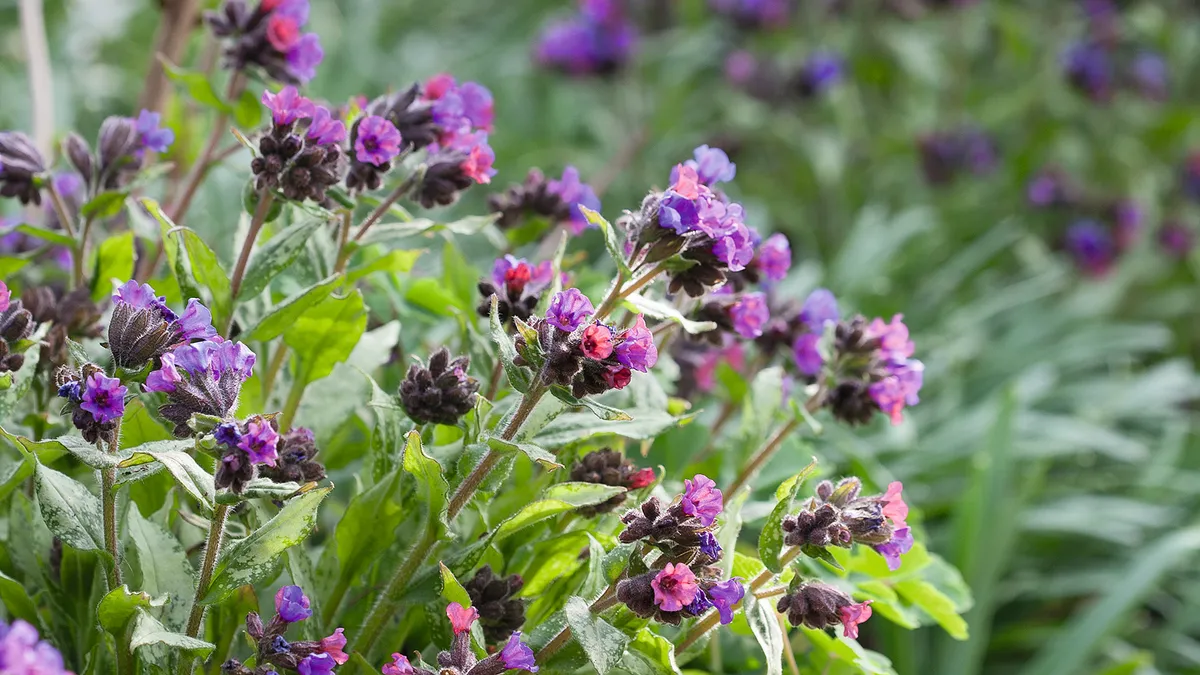
I generally don’t go for many variegated plants but this – and the very similar P. ‘Cotton Cool’ – is an exception. Its silvery leaves look good from spring to winter and has blue spring flowers. Much easier than hostas AGM. H 30cm. S 30cm. C Moist but well-drained soil; full to part shade. SI Year round. HR RHS H6.
Read our pulmonaria plant profile here.
RHUS TYPHINA ‘DISSECTA’
Like virtually all of my plant choices, this is a virtuoso multi-season plant. An open, multi- stemmed shrub with ferned foliage, and spectacular autumn colour. Suckering isn’t really a problem in naturalistic plantings – just cut to the ground along with the perennials, and the whole shrub can be coppiced. AGM. H 3m. S 2.5m. C Moist but well-drained soil; sun. SI Year round. HR RHS H6, USDA 3a-8b.
RUDBECKIA FULGIDA VAR. DEAMII
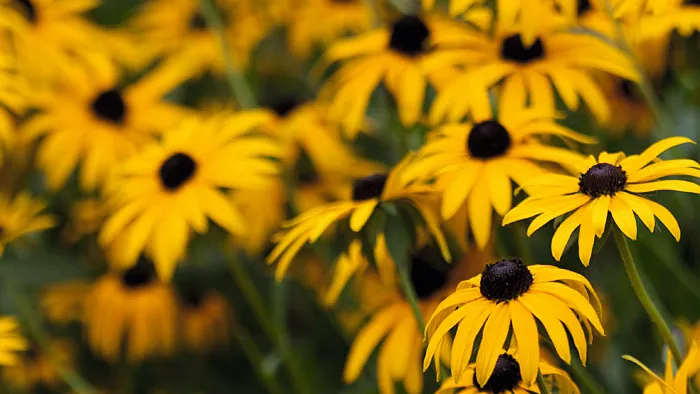
One I can’t do without. Soft apple-green foliage – much better than all the other cultivars including the better known Rudbeckia fulgida var. sullivantii ‘Goldsturm’ – and yellow flowers with black pincushion centres that last until late autumn. Plus perfect winter skeletons. AGM. H 60cm. S 40cm. C Moist but well-drained soil; full sun or half shade. SI Summer to winter. HR RHS H6, USDA 3a-9b.
SANGUISORBA ‘BLACKTHORN’
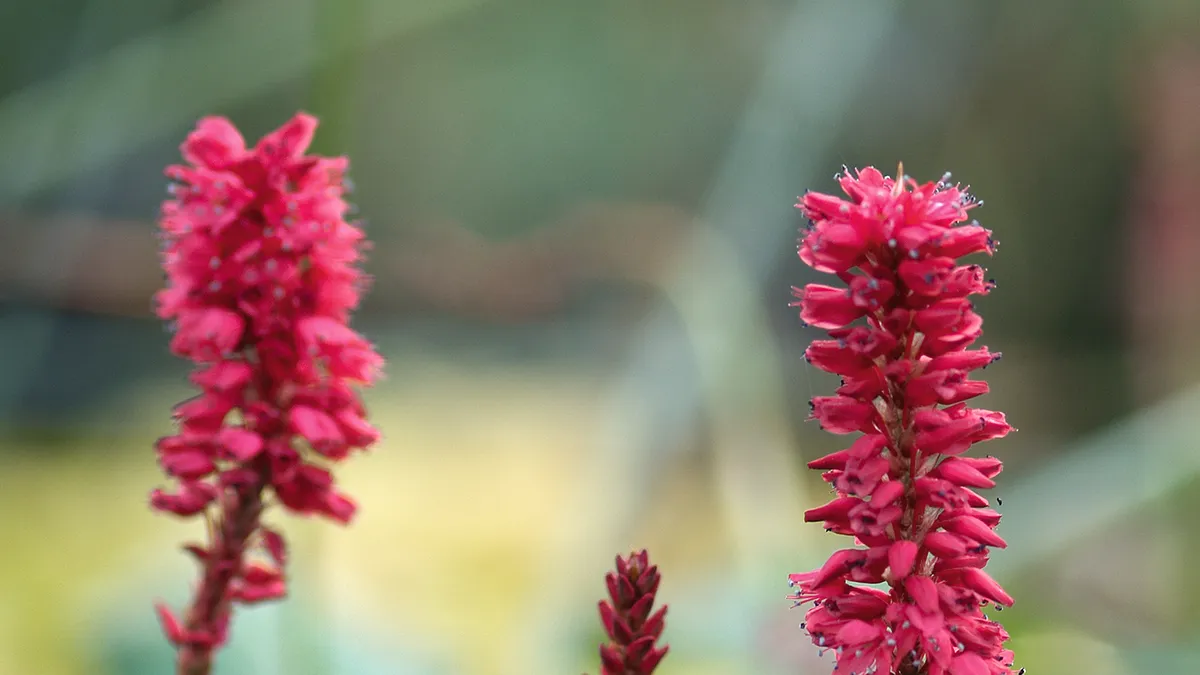
Low mounds of fresh ferny foliage and tall, upright stems holding narrow, strong pink flowers. Self-supporting and see through. Great in a meadowy planting with tall equally see-through Molinia cultivars. H 1.2m. S 40cm. C Moist but well-drained soil; full sun to part shade. SI Year round. HR RHS H7, USDA 4a-8b.
Learn how to grow and cultivate sanguisorbia.
THYMUS ‘JEKKA’
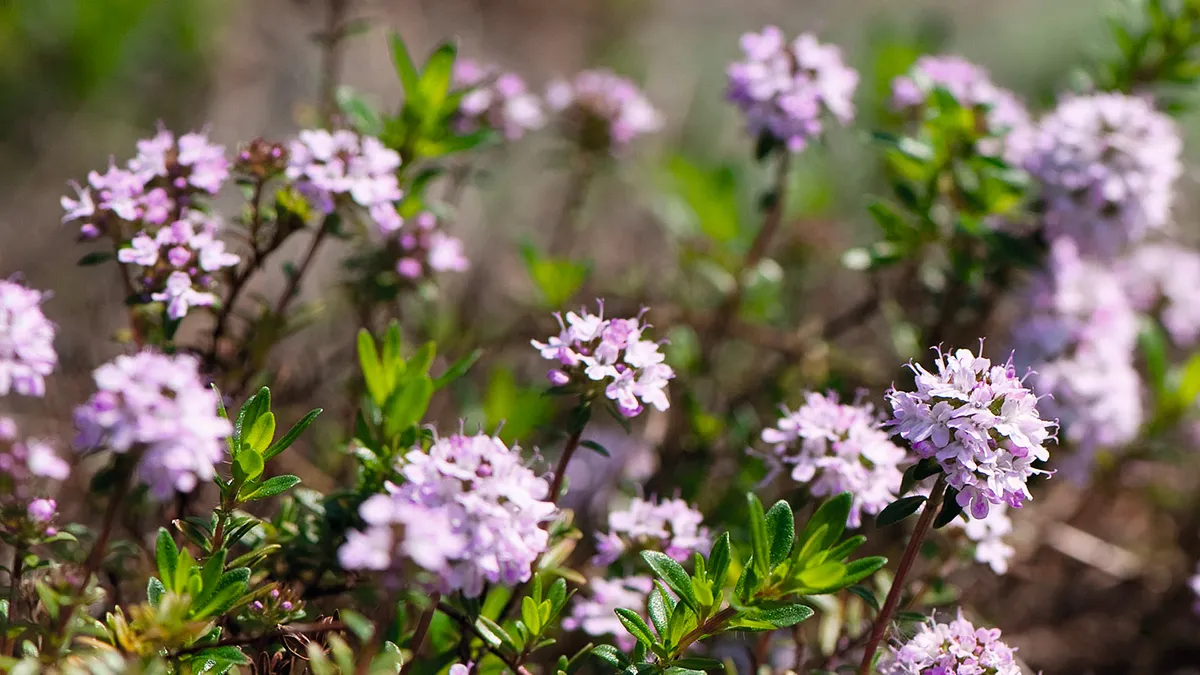
A really vigorous, totally bright, fresh, evergreen thyme that doesn’t become gappy or straggly. Ideal for groundcover in dry places, or trailing over walls. Covered in mauve flowers on long stalks in early summer. H 20cm. S 60cm. C Well-drained, neutral to alkaline soil; sun. SI Year round. HR RHS H6, USDA 5a-9b.
Marian Boswall
Marian’s selection includes plants that will protect soil, lock up carbon, and provide food and shelter for wildlife but, most of all, are simply very beautiful. marianboswall.com
AGASTACHE ‘BLACKADDER’
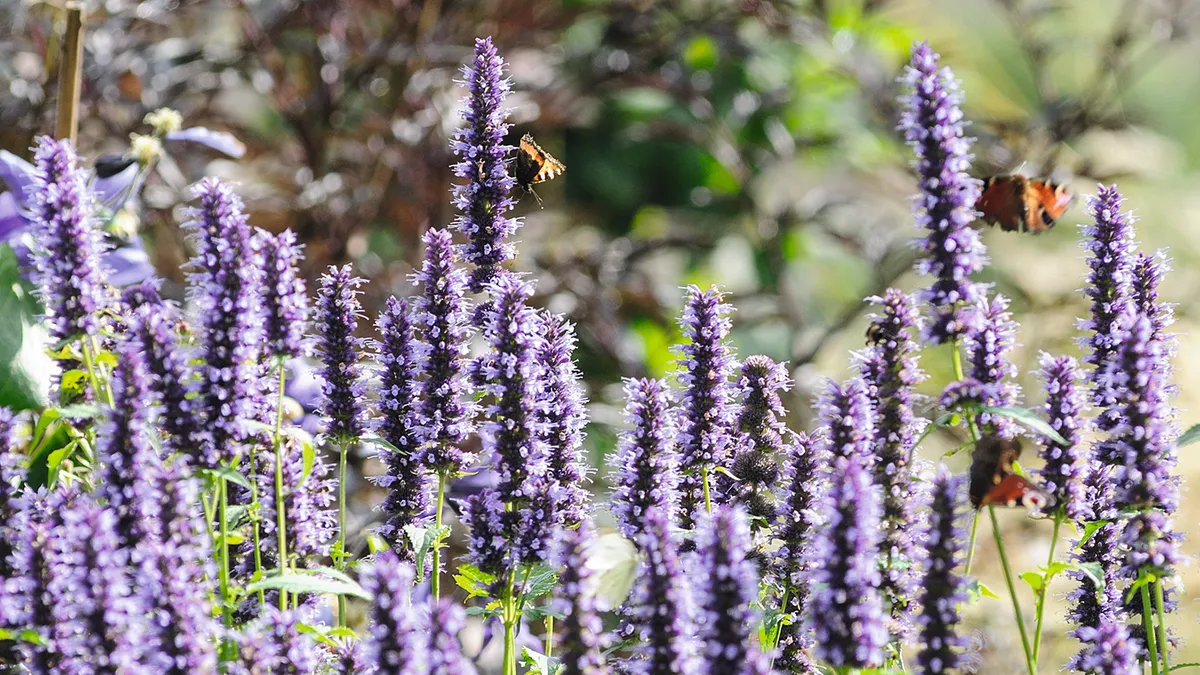
A member of the hyssop family, this perennial has long been used in herbal medicine as an antiseptic. This dark, giant cultivar is the most hardy and has edible flowers that go on for months and are always covered in bees. Resistant to drought and also happy in clay it makes a great vertical accent. H 70cm. S 50cm. C Well-drained, moderately fertile soil; full sun. SI June to November. HR RHS H4, USDA 6a-9b.
ALLIUM SCHUBERTII
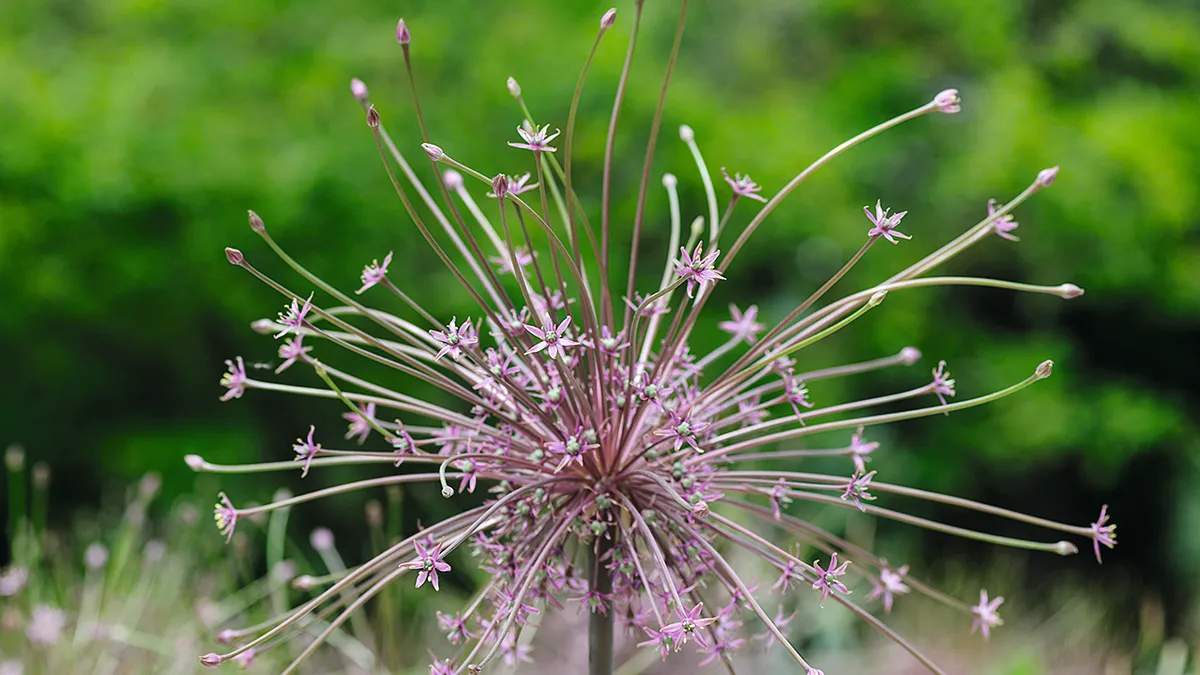
These enormous, lilac-coloured allium flowers look fabulously quirky in any border but are also great bee plants. The seedheads dry extremely well, creating super sustainable Christmas decorations. A perennial bulb. H 1m. S 1m. C Moist, well-drained soil; full sun or partial shade. SI April to May. HR RHS H4, USDA 5a-8b.
ARBUTUS UNEDO
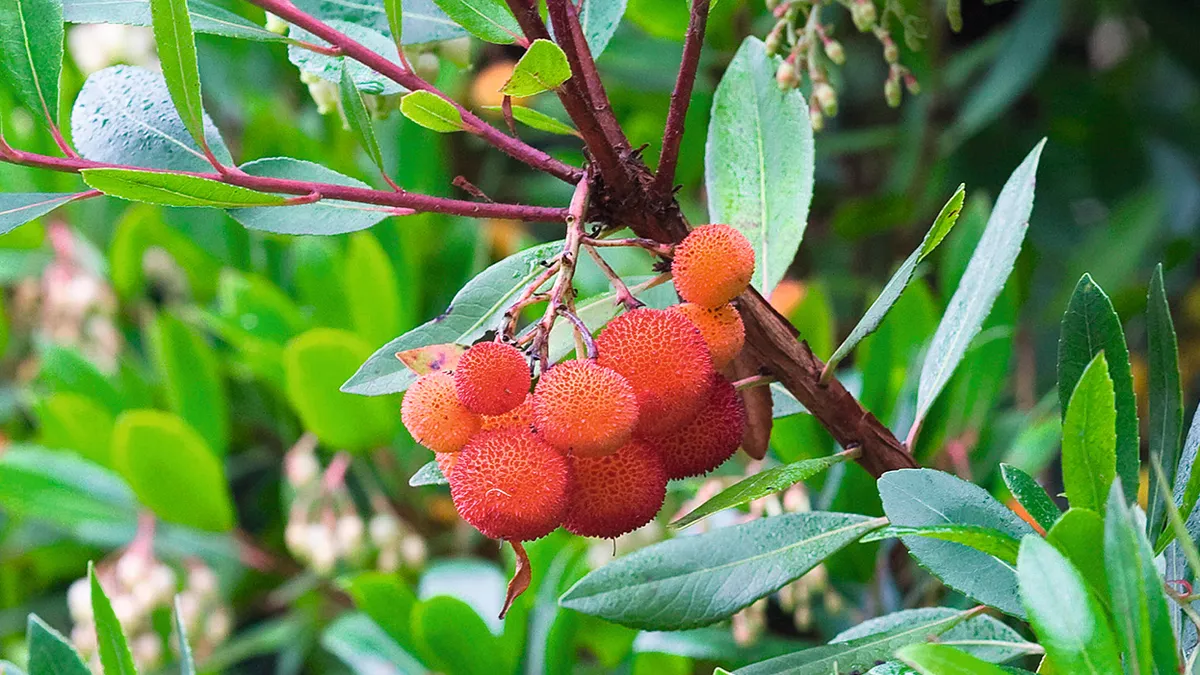
Flowering in winter this small, evergreen tree or large shrub is a useful forage plant for brave bees out on a cold sunny day. Its edible strawberry- like fruits make it a great permaculture tree to add the mid layer of a forest garden. H 5m. S 5m. C Moist, well-drained soil; full sun. SI September to January. HR RHS H5, USDA 7a-10b.
CALAMINTHA NEPETA
A bridesmaid for the front of every sunny border. A perennial from the Mediterranean, it does well on chalk and sand, and is also happy on clay. Loved by bees and caterpillars, it is deliciously aromatic so less loved by rabbits. H 30cm. S 45cm. C Well-drained, moderately fertile soil; full sun to partial shade. SI May to November. HR RHS H5, USDA 5a-7b.
CAMASSIA QUAMASH
A brilliant perennial bulb to naturalise in a meadow setting. The dark-blue spires above narrow leaves are loved by bees and need very little attention, spreading gradually by seed if they are happy. H 60m. S 50cm-1m. C Moist but well-drained soil; full sun or partial shade. SI April to May. HR RHS H4, USDA 5a-9b.
DIGITALIS LUTEA
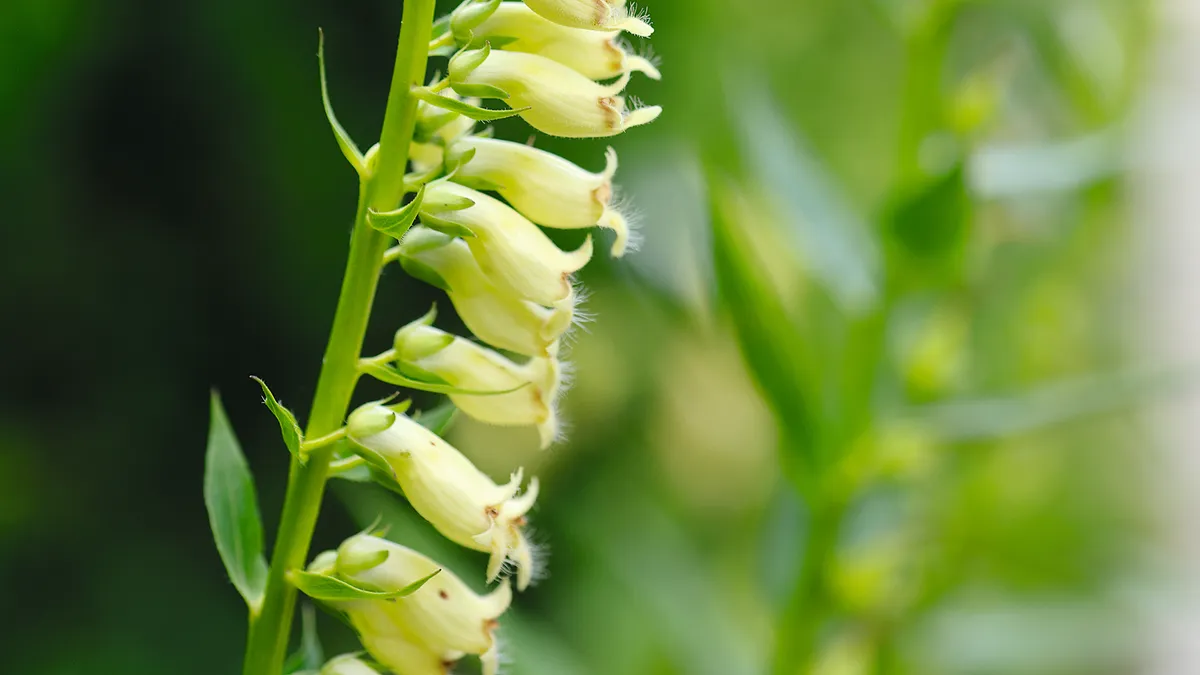
A tall and elegant beauty to brighten up a shady spot. Nodding trumpets provide a perfect landing spot for a bee. A short-lived perennial that looks great coming up through ferns and is less promiscuous than the common foxglove Digitalis purpurea. AGM. H 90cm. S 30cm. C Well-drained, moderately fertile soil; full sun to part shade. SI May to July. HR RHS H6.
We pick the best digitalis for colour and structure to grow here.
EPIMEDIUM GRANDIFLORUM ‘LILAFEE’
A key base-layer player that is ideal to cover and protect the soil to prevent erosion from heavy rain, and lock in carbon. This epimedium holds ts elegant pink flowers above the foliage, just cut them back in early spring before flowering. A super easy plant for shade. H 25cm. S 30cm.C Humus-rich, moist well-drained soil; part shade. SI Year round. HR RHS H5, USDA 5a-8b.
IRIS ‘BENTON NIGEL’
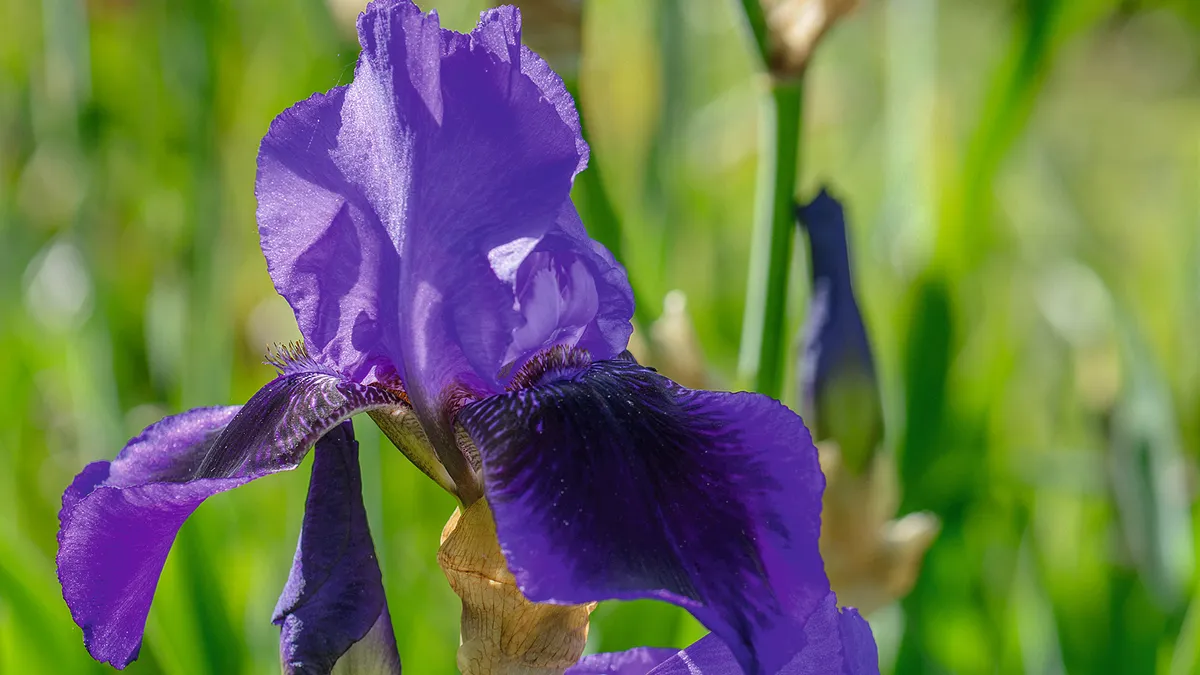
A pop of deep-blue colour that appears just when we need it, this elegant Cedric Morris iris is from the justly famous Benton stable of irises. These are less showy than modern bearded irises, and once you’re smitten with their subtle colours, I guarantee you’ll find yourself wanting to collect all the colours. H 1m. S 40cm. C Light, well- drained soil; full sun. SI April to June. HR RHS H4.
Don't miss our focus on the Benton irises.
LINUM PERENNE
A blue to stop you in your tracks, this lovely little perennial flax speaks of summer skies and linen frocks. Great for a gravel garden or dry front of border, it’s hardy but looks so delicate with large heads on slender stems. H 50cm. S 40cm. C Light, well-drained soil; full sun. SI June to August. HR RHS H4, USDA 5a-8b.
MAHONIA EURYBRACTEATA SUBSP. GANPINENSIS ‘SOFT CARESS’
The winter scent of a warm mahonia is such a waft of ‘welcome home’. This softer version of the shrub lacks the strident architecture of the usual mahonias and is easy to fit into any scheme. Good winter bee forage. AGM. H 60cm. S 12m. C Moist but well-drained soil; full sun to part shade. SI April to June. HR RHS H4, USDA 7a-10b.
MALUS ‘EVERESTE’
The humble crab apple finds a home in nearly every garden I design. In late winter the birds mob the pretty fruits when all else is gone. In spring, a daily visit to inhale the scent and listen to the bees is food for the soul. AGM. H 4-8m. S 4-8m. C Moist, well-drained soil; full sun or part shade. SI April to May. HR RHS H6, USDA 4a-8b.
NIGELLA DAMASCENA
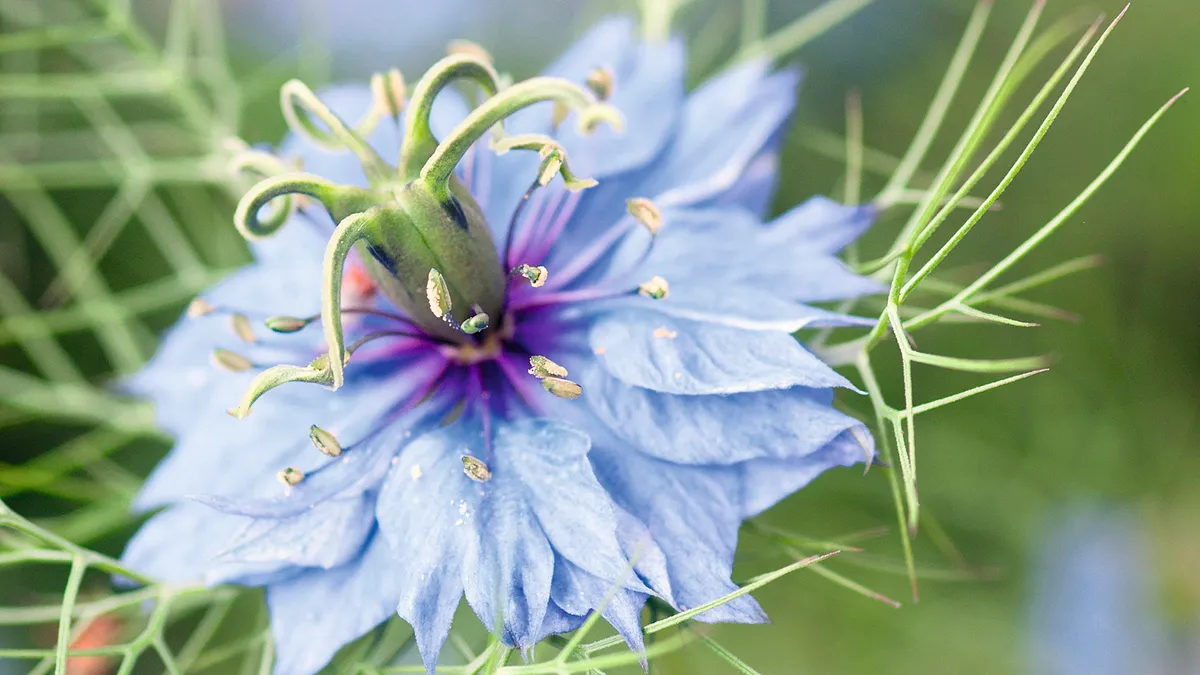
This hardy annual is so simple and yet so complex, with a centre like a passion flower and stunning seedheads too – a firm favourite for dry gardens especially. Great for bees, this is an annual that easily self-seeds, and the seeds are edible too. H 45cm. S 25cm. C Light, well- drained soil; full sun. SI June to November. HR RHS H3, USDA 2a-11.
ORIGANUM ‘KENT BEAUTY’
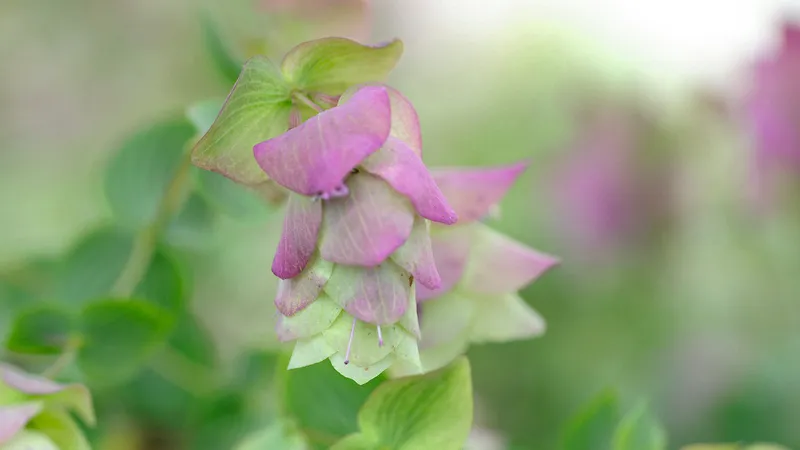
Very sweet nectar makes this a bee and butterfly magnet, and the unusual pink flowers drip down among bracts like hops, making it a very Kentish plant. Great for pots and window boxes where the scent can drift in when brushed. AGM. H 30cm. S 20cm. C Light, well- drained soil; full sun. SI July to September. HR RHS H4, USDA 6a-9b.
ORLAYA GRANDIFLORA

If you have only one annual, this has to be it. The most delicate of umbels that threads up through the border or in the gravel garden, pure white and brimming with forage for pollinators right to the first frosts. A hardy annual it self- seeds in light soil. AGM. H 60cm. S 60cm. C Light, well-drained soil; full sun. SI June to October. HR RHS H7.
- Buy now from Thompson & Morgan (£2.71)
PHACELIA TANACETIFOLIA

A plant that helps feed both the soil and the bees. Phacelia is a pretty, green manure that you cut down while in flower to allow the nutrients to stay below. It will hum with beneficial insects all summer, a fast groundcover and prolific self-seeder. H 1.2m. S 45cm. C Any fertile soil; full sun. SI June to September. HR RHS H4.
- Buy now from Crocus (£2.99)
PRUNELLA VULGARIS
An easily overlooked, but key wildflower meadow plant. Self heal is also an essential healing herb and soil-knitting stalwart in the sward. Drink it in an infusion, or leave for the bees. H 20cm. S 20cm. C Moist but well-drained soil; full sun or partial shade. SI April to August. HR RHS H5.
ROSA ‘DUNWICH ROSE’

A shrub rose that looks just as at home in a wild garden as it does in a more polite setting. Single, creamy flowers are stunningly simple and a perfect landing spot for pollinators. In the autumn dark-blue hips provide a real talking point and food for birds too. H 60cm. S 1.2m. C Moist, well-drained soil; full sun or partial shade. SI April to June. HR RHS H6, USDA 3a-9b.
RUDBECKIA OCCIDENTALIS: ‘GREEN WIZARD’
A tough prairie perennial that does well in most places including heavy soils in sun. The unusual cone heads are food for butterflies and bees and the seedheads stand through the winter attracting goldfinches and look striking against a low, winter sun. H 1.2m. S 60cm. C Any fertile soil; sun or part shade. SI August to October. HRRHSH7.
- Buy now from Thompson & Morgan (£9.29)
SAMBUCUS NIGRA
Small tree or shrub. A beautiful addition to any sustainable garden. The pretty, spring flowers and deep purple autumn fruits are both delicious and used medicinally. Plus great forage for wildlife. H 4m. S 3m. C Moist, well-drained soil; full sun. SI Spring and autumn. HR RHS H6, USDA 5a-8b.
SELINUM WALLICHIANUM
With masses of starry parsley heads above pretty, fern-like, cut leaves, this is a delightful froth of bee fodder for any border. Its red stems look wonderful with Sanguisorba ‘Tanna’ bobbing through. A medicinal plant in the permaculture garden. AGM. H 1m. S 1m. C Moist, well-drained soil; full sun. SI July to September. HR RHS H6, USDA 6b-10b.
VIBURNUM CARLESII
With a perfume to turn heads in early summer, this is my favourite of this useful genus. Flowers are white to pink in pom-poms with red edges, and are loved by bees. The glossy green leaves turn red edged in autumn. A fabulous mid layer shrub. H 1.8m. S 2m. C Moist, well-drained soil; full sun to full shade. SI April to July. HR RHS H6 USDA 4a-7b.
Olivier Filippi
A pioneer of drought-tolerant planting, Olivier has selected plants from his Mediterranean garden that are as ornamental as they are functional, and are already grown in UK. jardin-sec.com
ACHILLEA COARCTATA
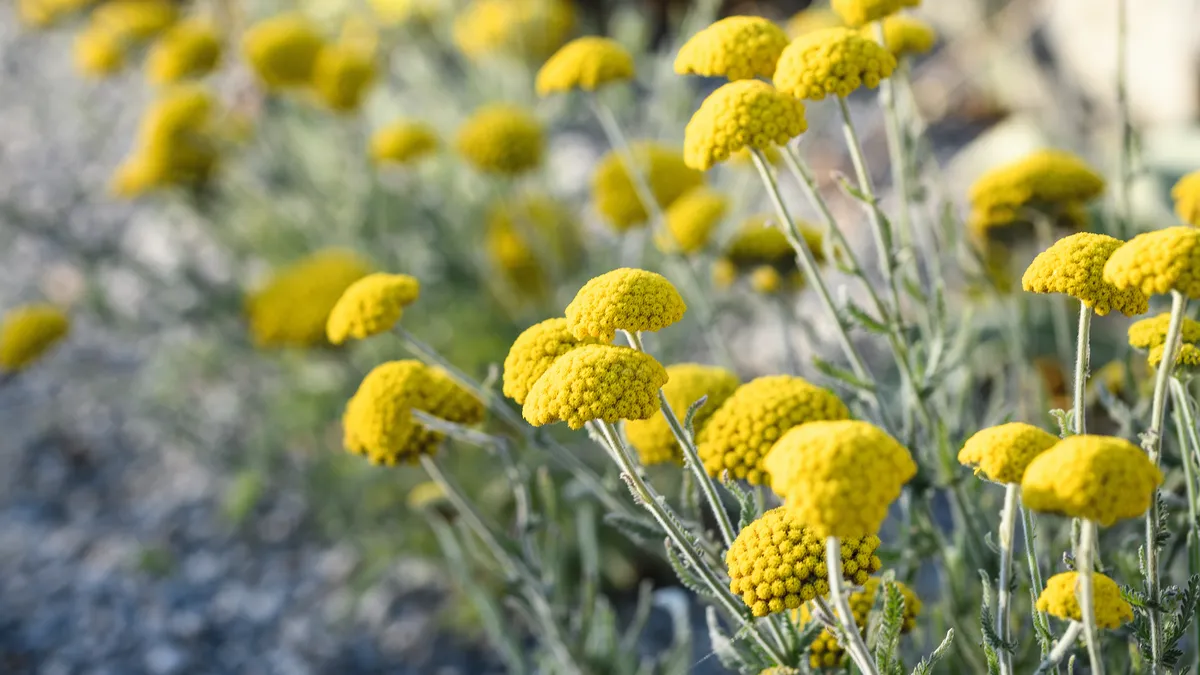
An elegant groundcover from Turkey and the Balkan region with finely cut, silver-grey leaves growing in downy rosettes and contrasting with the bright-yellow flowers. Its strong rhizomes can check erosion on slopes. H 30cm. S 60cm. C Dry, poor soil; full sun. SI Year round. HR RHS H5.
ARBUTUS X THURETIANA
This A. andrachne x A. canariensis hybrid is a wonderful strawberry tree for milder climates. Spectacular bark in June: the old orange-red peeling bark reveals a smooth, new, green bark. H 8m plus. S 4m. C Tolerates a wide range of soils; full sun or part shade. SI Year round. HR RHS H4.
CENTAUREA BELLA
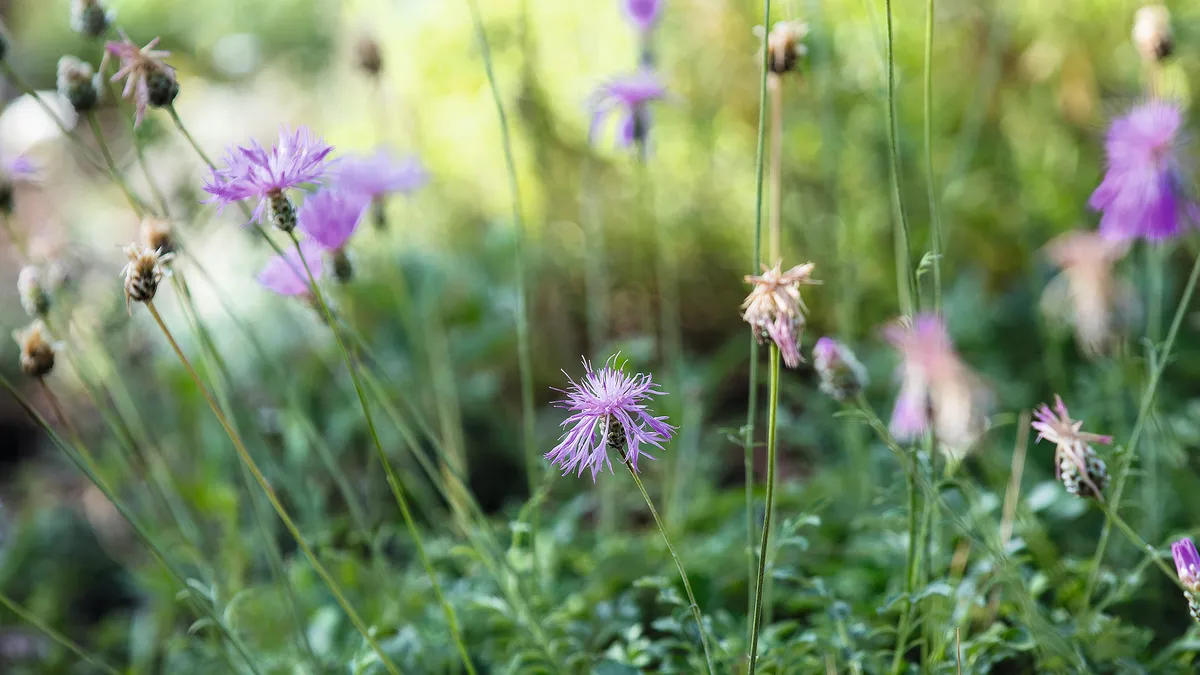
One of the best evergreen groundcovers for dry gardens and attractive to butterflies. Needs little weeding as the plant releases germination inhibiting compounds (allelopathy). H 20cm. S 40cm. C Tolerates a wide range of soils; full sun or partial shade. SI Year round. HR RHS H5.
CISTUS X PORPHYREUS ‘PURPLE PATCH’

An attractive new selection bred by Yorkshire Cistus specialist Bob Page. Aromatic, evergreen foliage and large, purple flowers with dark blotches. H 1m. S 1m. C Best in poor, stony or sandy, dry soils; full sun. SI May to June. HR RHS H4.
CONVOLVULUS OLEIFOLIUS
The narrow, silky silver leaves are covered by a mass of pale-pink flowers in summer. Excellent in coastal gardens, as it’s extremely tolerant to salt-laden wind. The plant grows as a dense cushion, perfect in a gravel garden. H 30cm. S 40cm. C Poor, well- drained soil; full sun; SI Year round. HR RHS H4.
EUPHORBIA RIGIDA
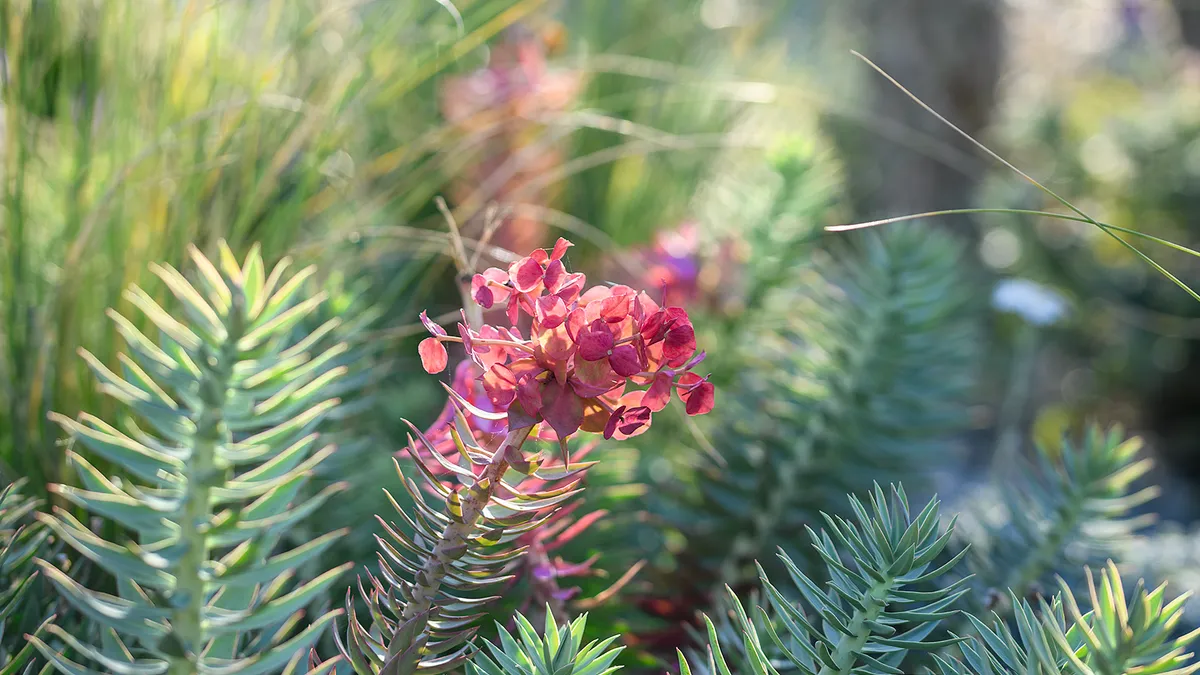
The striking silver-blue leaves that spiral around the 69 stems take on a pink tinge in winter. Flowerheads stay attractive over a long period; bright-yellow in winter, orange in spring and fading to crimson in early summer. Self-seeds easily. AGM. H 30cm. S 50cm. C Well-drained soil; full sun. SI Year round. HR RHS H6, USDA 7a-10b.
LINARIA VENTRICOSA
A ‘giant’ Linaria from the Tizi-n-Test pass in Morocco’s High Atlas mountains. Steel blue-silver leaves, strong bushy growth and long spikes with pink-veined, yellow, velvety flowers. H 1.5m. S 80cm. C Best in poor, stony or sandy, dry soils; full sun. SI Year round. HR RHS H4.
LOMELOSIA MINOANA
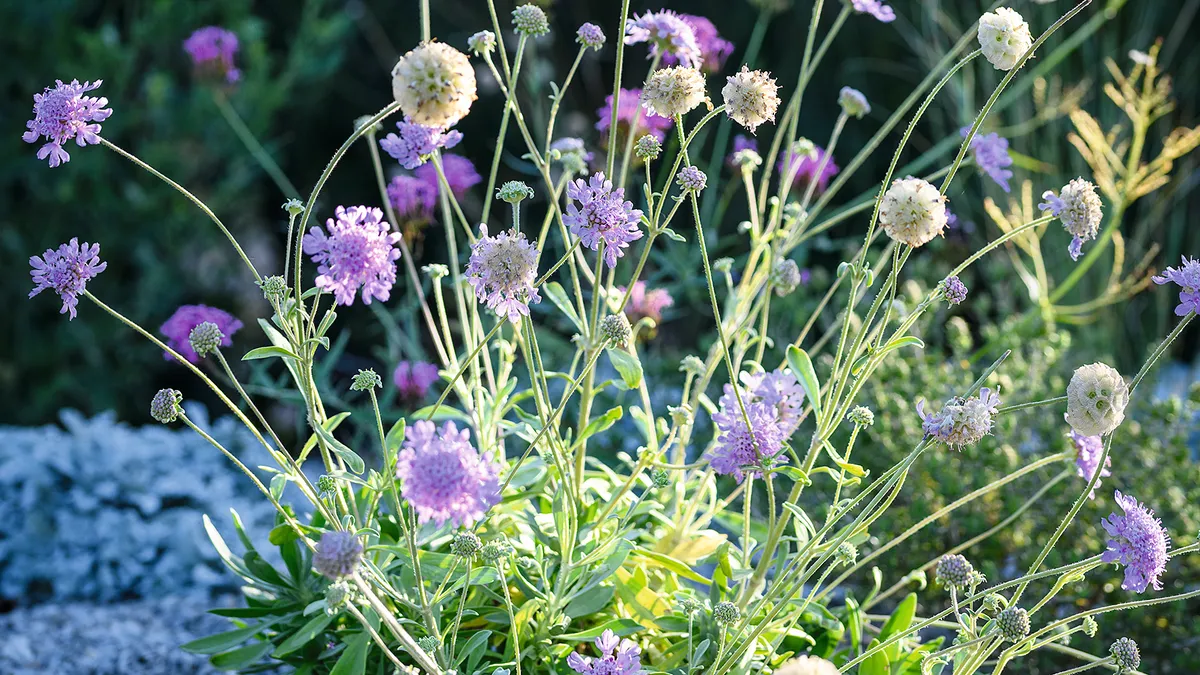
This sub-shrub from southern Crete is probably one of the most attractive plants for dry gardens. Soft, velvety, grey-green foliage and dense mounding habit. The lilac flowers in spring are followed by fluffy seedheads that stay attractive all summer. H 80cm. S 1.2m. C Well-drained, dry soil; full sun or partial shade. SI Year round. HR RHS H4.
ORIGANUM ‘CLARA’
A chance seedling that was found in our garden, this free-flowering hybrid is a cross between O. syriacum and O. majorana var. tenuifolium. Highly aromatic, silver, evergreen foliage, abundant white flowers in early summer, very attractive to insects. H 80cm. S 60cm. C Best in poor, stony or sandy, dry soils; full sun. SI Year round. HR RHS H4.
PETROMARULA PINNATA
The rosette of salad-looking leaves – the name Petromarula is Greek for ‘rock lettuce’ – produces fast-growing spikes covered with pale-blue flowers. This Cretan species from the Campanulaceae family thrives in the rockery at the Royal Botanic Gardens, Kew. It can be short-lived but it self-seeds easily. H 80cm. S 60cm. C Best in poor, stony or sandy, dry soils; full sun. SI Spring. HR RHS H4.
RETAMA SPHAEROCARPA
A fast-growing shrub with flexible, bushy, silver-coloured vegetation. In early summer, the shrub bends under the weight of thousands of soft golden flowers. The Spanish name, lluvia de oro, translates as rain of gold, and gives a good idea of what the plant looks like in bloom. H 3m. S 1.5m. C Tolerates a wide range of soils; full sun. SI Year round. HR RHS H5.
SALVIA DORYSTOECHAS
An aromatic, medicinal perennial, used as a herbal tea in Anatolia, this is a highly desirable plant for a scented garden. White flowers on long spikes from May to July. H 60cm. S 60cm. C Poor, well-drained soil; full sun or partial shade. SI Spring to summer. HR RHS H4.
SALVIA MULTICAULIS
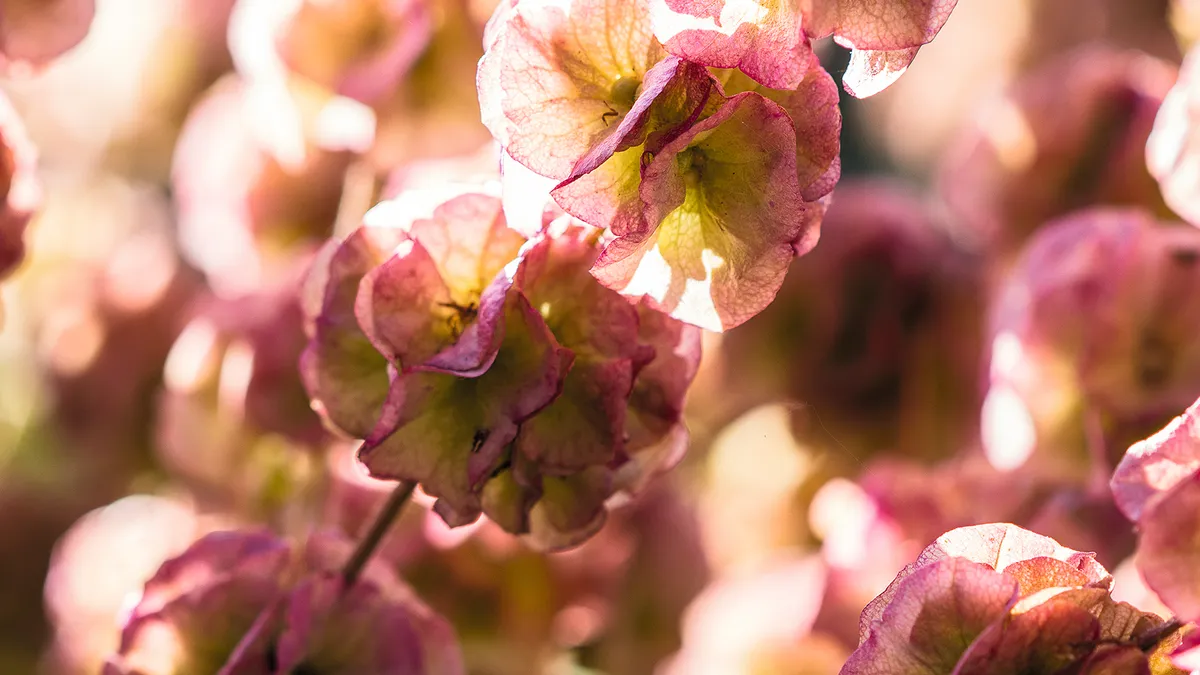
The small, violet flowers of this aromatic perennial. grow out of large crimson calyces. Extremely attractive as a rockery plant or small groundcover for gravel gardens. AGM. H 25cm. S 30cm. C Best in poor, stony or sandy, dry soils; full sun. SI Spring. HR RHS H3.
Here are more salvias to grow in the garden.
SIDERITIS CYPRIA
This lovely sub-shrub is endemic to the limestone ridges of the Kyrenia Mountains in northern Cyprus. Its whorls of lime-green flowers on reddish stems contrast with the silver-coloured, woolly foliage Often short-lived but self-seeds freely. H 50cm. S 30cm. C Poor rocky soils, needs excellent drainage; full sun. SI Year round. HR RHS H4.
STACHYS LAVANDULIFOLIA
A tough perennial that is cold and heat tolerant, from Caucasus steppes. Dense, silver foliage, silky whorls of small, lilac flowers. A lovely groundcover for gravel gardens. H 25cm. S 50cm. C Best in poor, stony or sandy, dry soils; full sun. SI Year round. HR RHS H5.
THYMUS MASTICHINA
Mastic thyme, a sub-shrub that originally comes from the mountains of southern Spain, has one of the strongest fragrances among all aromatic plants from the Mediterranean. The nectar produced by the small white flowers is highly attractive to bees and other beneficial pollinating insects. H 30cm. S 25cm. C Poor rocky soils, needs excellent drainage; full sun. SI Year round for the fragrant foliage, spring for the flowers. HR RHS H4.
Conrad Batten
Conrad’s plant choices reflect the naturalistic spaces with sustainability at heart that are key to his design ethos, and offer an immersive and transportive experience. conradbattendesign.co.uk
Don't miss one of our favourite gardens by Conrad.
ASPHODELUS ALBUS
In spring the flower spikes rise from a tight whorl of glaucous strap leaves – the essence of the Mediterranean in a bulb. Height (H) 1.2m. Spread (S) 30-50cm. Conditions (C) Adaptable, prefers alkaline and stony soil; full sun. Season of interest (SI) Early summer. Hardiness rating (HR) RHS H4, USDA 6a-8b .
BLECHNUM SPICANT
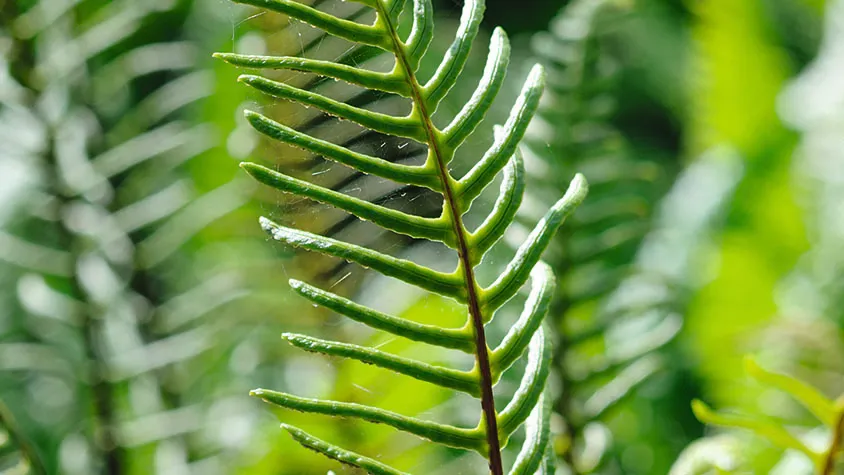
Known as the hard fern, this tufted evergreen fern helps brighten shady areas and combines well with many other shade-loving plants. AGM*. H 10-50cm. S 10-50cm. C Poorly drained, humus- rich soil; full sun to part shade. SI Year round. HR RHS H6, USDA 5a-8b.
BRIZA MEDIA
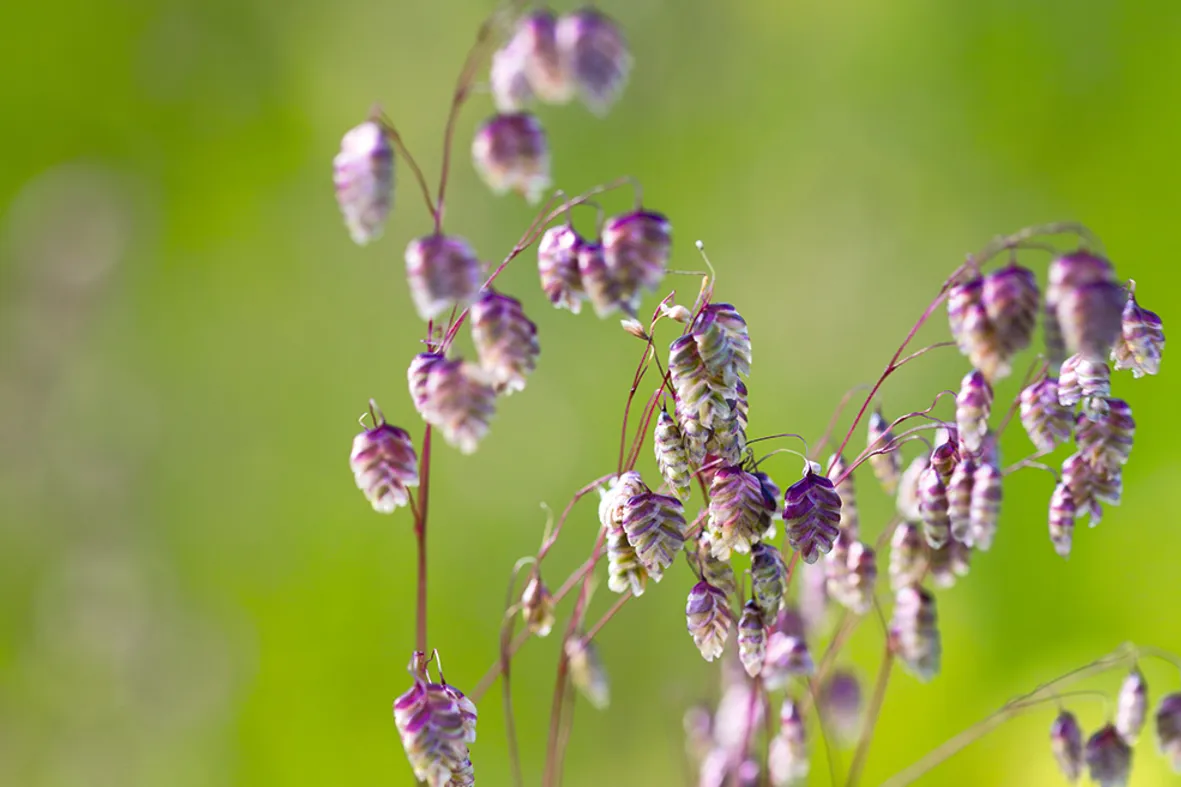
Acts on the muting mauves and scumbling yellows of meadows. A short-lived, quivering, tufted clump of delight. H 30-75cm. S 10-30cm. C Well-drained soil; full sun. SI Year round. HR RHS H7, USDA 4a-8b.
CORYLUS AVELLANA
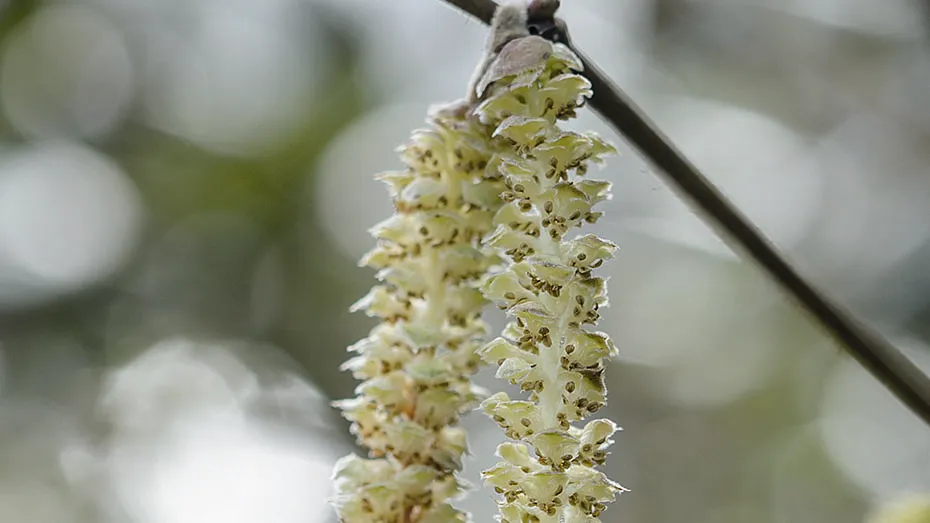
A deciduous tree with yellow catkins in spring followed by hazel nuts in autumn. Leaves turn a rich yellow before they fall in October. H 4-8m. S 4-8m. C Moist but well-drained soil; part shade to full sun. SI Year round. HR RHS H6, USDA 4a-8b.
CRATAEGUS MONOGYNA
In the spring, the cream flowers of this deciduous tree buzz with life and are followed in autumn by rich berries. When leaves fall they reveal the purple of spiny twigs; each hawthorn has a story told through twisted stem and branch. H 4-8m. S 4-8m. C Moist but well-drained soil; part shade to full sun. SI Year round. HR RHS H7, USDA 4a-7b.
DAUCUS CAROTA
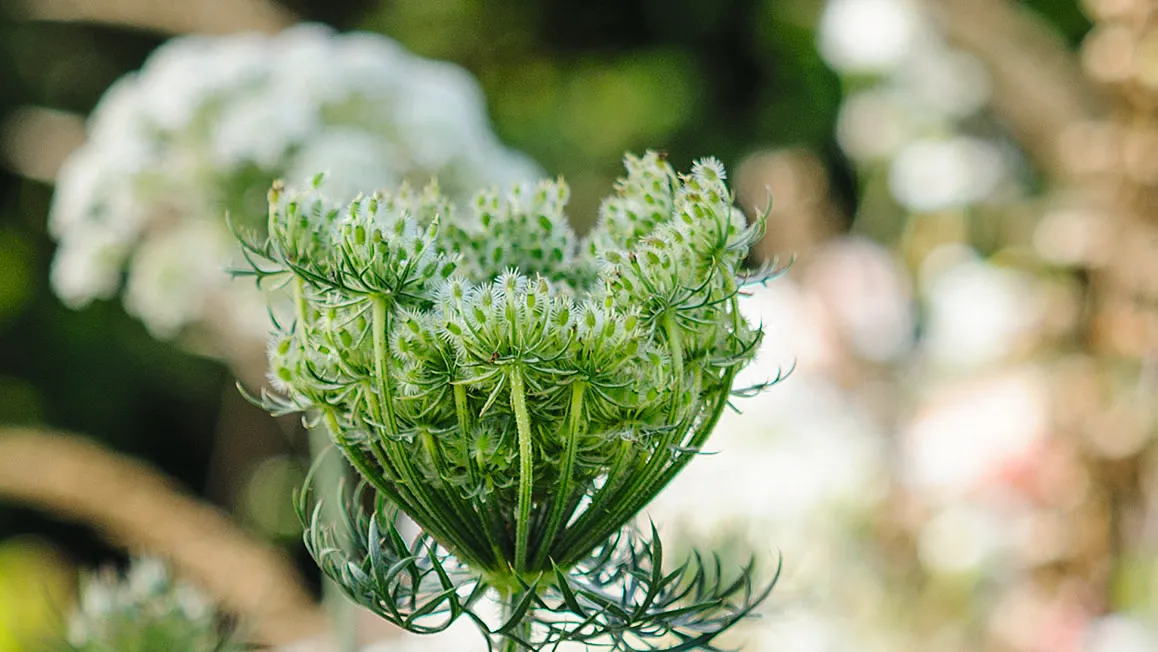
The wild carrot’s white umbels, occasionally with a blush that swirls around a central purple pin, froth through high-summer plantings. Seeds sprout green in autumn’s nest-like seedheads. H 30-75cm. S 30cm. C Well-drained soil; full sun. SI Spring to autumn. HR RHS H7.
DIGITALIS CANARIENSIS
Burnt-orange, flame-flicked flowers with an apricot blush, rise from deep-green leaves on woody, stiff stems. The spires of bell-shaped flowers grow to varying heights creating candelabra-style colour. H 75cm-1.5m. S 75cm-1m. C Rich soil; sun and shelter, frost tender. SI Summer. HR RHS H2.
GERANIUM NODOSUM

In spring the young leaves of this knotted cranesbill unfurl like stretched hands. The pink petals, which have a metallic sheen, have a curious swaying habit. An excellent groundcover for the dappled shade of a tree. H 10-50cm. S 10-50cm. C Moist but well-drained soil; full sun to full shade. SI Spring to autumn. HR RHS H5.
HOLBOELLIA LATIFOLIA
Known as the sausage vine for its sausage-shaped, fruits in autumn, this vigorous evergreen climber carries flowers through early spring that have the sweetest fragrance. Adaptable, but best in part shade and needs some sun for flowers. H 4-8m. S 2.5-8m. C Moist but well-drained soil; full sun to full shade. SI Year round. HR RHS H4.
LOTUS HIRSUTUS
Semi-evergreen shrub with soft, hairy grey foliage you can’t resist brushing the back of your hands against. Clustered white and pink-tinted flowers run to chocolate seed capsules. AGM. H 50cm-1m. S 50cm-1m. C Well-drained soil; full sun. SI Year round. HR RHS H4.
LUZULA SYLVATICA
An evergreen perennial sedge that forms clumps of ribbon leaves, edged with hairs. The open flowers rise above the foliage in May and June on stiff stalks. H 50cm-1m. S 50cm-1m. C Moist, rich, poorly drained soil; part to full shade. SI Year round. HR RHS H7.
MALVA MOSCHATA
Known as musk mallow, this perennial creates a flutter presence in a meadow planting, or can be a shadow player on steps or by a wall. Its veined, torn- edged flowers are a middling pink. H 50-90cm. S 20-50cm. C Moist but well-drained soil; full sun. SI Spring to autumn. HR RHS H5, USDA 3a-8b.
- Buy now from Thompson & Morgan (£1.79), Crocus (£2.99)
PERSICARIA AMPLEXICAULIS ‘BLACKFIELD’
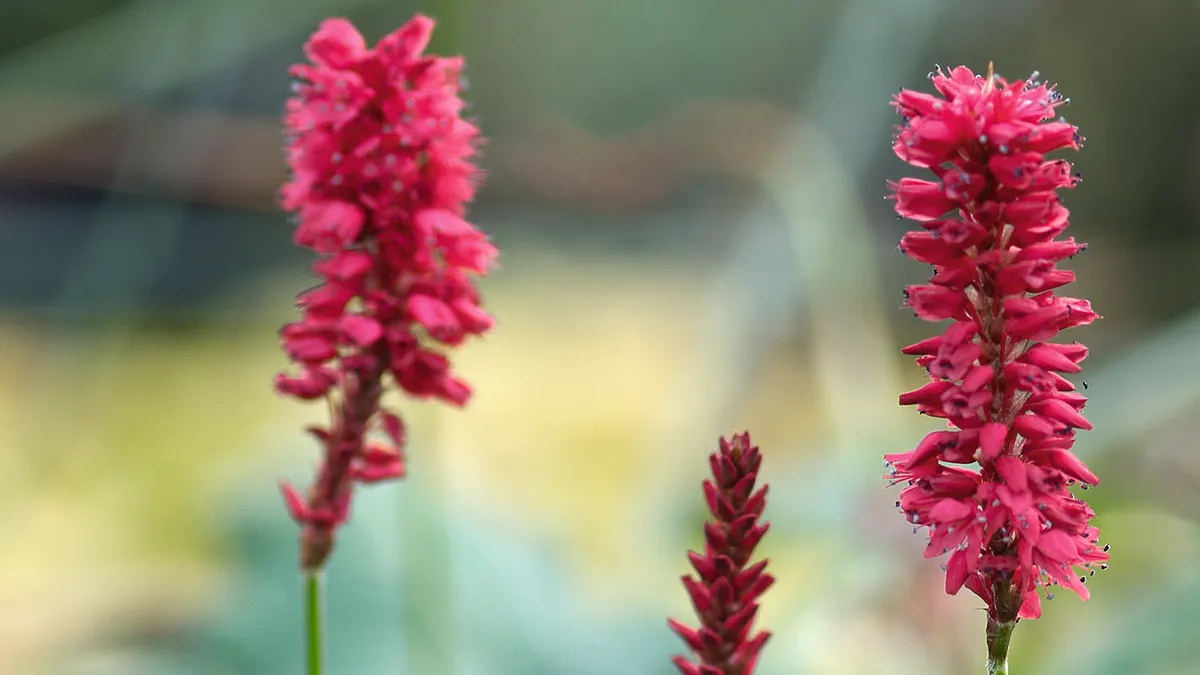
Blood-red flowers, carried on long, ranging stalks, work brilliantly as paint flicks of colour through grasses. Loved by pollinators, this clump-forming perennial has a long flowering period, and offers interest even when not in flower, especially in autumn when the trowel-shaped leaves take on chromatographic colour. H 50cm-1m. S 50cm-1m.
PRUNUS CERASIFERA
In early spring, the cherry plum offers clouds of delicate, pink-tinged white blossom, while even the hawthorn still slumbers. Followed by edible plum-like fruits in autumn. Dark-grey speckled bark, develops fissures with age. H 8-12m. S 8m. C Adaptable but best in moist but well-drained soil; full sun or part shade. SI Spring and autumn. HR RHS H6, USDA 5a-8b.
ROSA ‘NOISETTE CARNÉE’
A climbing rose that is often still flowering at the end of November. Its small clusters of warm pink blooms are held on mid-green leaves. The clove scent is so delicious you simply want to close your eyes and drink it in. AGM. H 2-3m. S 3m. C Rich, moisture-retentive soil; part shade to full sun. SI Spring to autumn. HR RHS H4.
ROSMARINUS OFFICINALIS: ‘POINTE DU RAZ’
The tufted, flicked pillow hair stems of this aromatic shrub grow into a knotty, twisted mound that makes a great groundcover or trailing plant. In May and June it is topped with clear violet-blue flowers that are excellent added to a rocket salad. H 10-90cm. S 10-90cm. C Dry, well-drained soil; full sun. SI Year round. HR RHS H4.
RUMEX ACETOSA
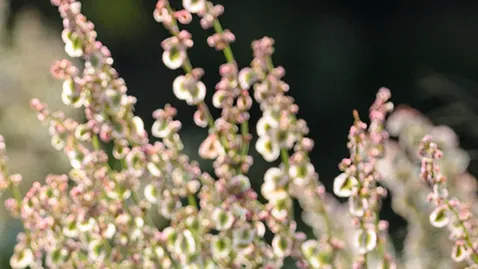
The common sorrel throws up skyward wires of toasted-red flowers from mid to late summer. A low green presence, with apple-tasting leaves. Use it to stitch planting schemes together. H 50-75cm. S 10cm. C Well-drained soil; part shade to full sun. SI Summer. HR RHS H7, USDA 3a-7b.
SARCOCOCCA CONFUSA

Known as sweet box, this evergreen shrub is a winter enchanter, when all is quiet. A plant to linger by, and take in its sweet aroma on cold days when the temptation is to hurry on your way. The white tufted flowers hug the stem nestled in the leaf crook. H 1.5-2.5m. S 1-2m. C Moist but well-drained soil; full to part shade. SI Year round. HR RHS H5.
SYMPHYTUM ‘HIDCOTE BLUE’
From crumpled leaves rise bell-like flowers, held in a cluster. Warm pink in bud, they open to light ink blue, bringing early delight to bees. Easily propagated by root cuttings, it is an excellent groundcover but can be tricky to dig out as any small section of root left behind can sprout a new plant. AGM. H 30-50cm. S 50-75cm. C Moist soil; sun or part shade. SI Spring and summer. HR RHS H7, USDA 4a-8b.
THALICTRUM ‘ELIN’
Leaves push from the ground in early spring, dark purple in their first flush before mellowing to a more glaucous green. The flowers rise and sway on tall stems, creating a haze of lavender- pink flower that demands to be stroked. AGM. H 1.5-2.5m. S 50cm-1m. C Moist but well-drained soil; part shade. SI July and August. HR RHS H7.
*Holds an Award of Garden Merit from the Royal Horticultural Society. Hardiness ratings given when applicable.

